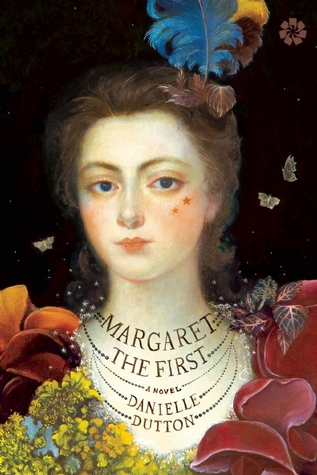Margaret the First by Danielle Dutton
(Scribe)
Pp. 160
Margaret Cavendish was a poet,
philosopher and visionary. As a child she created imaginary worlds (populated
with thinking-rocks, humming-shoes, her favourite sister and Shakespeare, Ovid
and Caesar) and stitched little books together with yarn. “Eventually she
achieved fame, but it was not necessarily that which she sought, as children
chased after her carriage calling out to ‘Mad Madge’ and she became a
cautionary tale for young girls who dreamed of becoming too intelligent.
With the civil
war raging, she joined the court of Queen Henrietta Maria and followed her into
exile in France, where she met and married the much older William Cavendish,
Duke of Newcastle. William
was generally very supportive of her work and encouraged her to speak up and
express her thoughts. Through him, Margaret came into contact with many of Europe’s leading thinkers; but she was bashful and
awkward in society. When she was invited to speak at The Royal Society (the
first woman to be so invited, and the last for 200 years) she could only
stammer appreciation and rush away; causing Samuel Pepys to write, “A mad,
conceited, ridiculous woman. I do not like her at all.”
As a woman who published books of
her thoughts, she was considered doubly shocking. First that she had them,
which was scandalous enough, but to voice them was even more so. Furthermore,
she was childless, attempted cures for which included syringing herbs into her
womb and “a drench that would poison a horse.”
Many of her thoughts centred on the
physical world. As well as poetry and philosophy she wrote and published works
of extraordinary utopian science fiction and fantasy. In her book, Philosophical and Physical Opinions,
1655, against the prevailing ideas of the time, “I argued all matter can think:
a woman, a river, a bird. There is no creature or part of nature without innate
sense and reason, I wrote, for observe the way a crystal spreads, or how a
flower makes way for its seed.”
In contrast with much current
weighty (in size) historical fiction, this short novel (160 pages) covers
historical events in brief detail; The English Civil War is dealt with very
succinctly:
“The King of England was
convicted of treason. Then the King of England was dead. It was Tuesday. It was
1649. Parliament hacked off Charles I’s head outside the Banqueting House at Whitehall.”
Halfway through the novel, Danielle Dutton changes from first-person to third-person
narration. This ambitious move reflects the fame Margaret sought as people began
to talk about her after the coronation of Charles II, and the Cavendishes’
return to London.
While Danielle Dutton doesn’t
claim Margaret specifically as a proto-feminist, she does dwell on her issues
with equality, or the lack thereof. Indeed, the title comes from her own
self-honorific. “Though I cannot be Henry the Fifth, or Charles the Second, yet I endeavour to be Margaret the First”. She was far from
saintly, however, and, jealous of William’s success, she upstaged him at the
opening of his play by attending the theatre with her breasts bared and her
nipples painted.

No comments:
Post a Comment